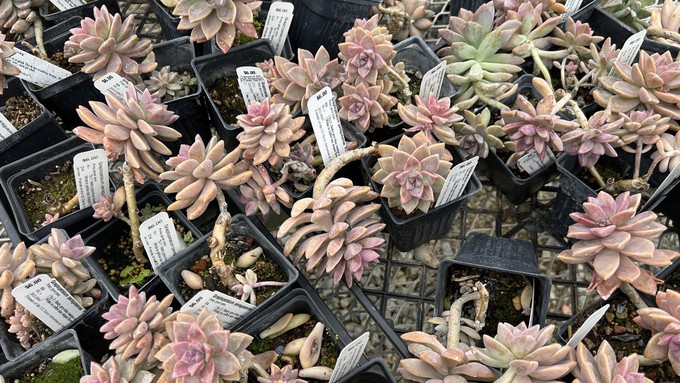
UC Davis Arboretum Teaching Nursery hosts second fall fundraiser

These little succulents are known as pinky ghost plants (Graptopetalum paraguayense 'Pinky') -- how appropriate for Halloween! The UC Davis Arboretum Nursery will have 24 of these available at the Oct. 26 sale. Kathy Morrison
Fall is the best time to plant water-wise perennials, shrubs and trees, especially California natives.
Which means this Saturday may be the best day to buy those plants, too.
On Saturday, Oct. 26, the UC Davis Arboretum Teaching Nursery hosts one of its largest sales of the year. In stock and ready to go are more than 20,000 plants in nearly 800 varieties – all water-wise and proven to thrive in the greater Sacramento area.
The hardest part? Choosing which plants to bring home. The Arboretum staff has some suggestions.
“Need plants? But you’re not sure which are right for your spot?” ask the organizers. “Create a wish list using our online inventory with photos, then shop for them at this Saturday’s Plant Sale at the UC Davis Arboretum Teaching Nursery! PRO TIP: Filter by category – low-water, shade, California native, Future Favorite, etc.”
Find the inventory link here: https://arboretum.ucdavis.edu/plant-sales
Need more ideas? Take a look at the nursery’s demonstration gardens featuring Arboretum All-Stars and other flowering favorites.
The sale begins with a members-only hour from 9 to 10 a.m. for the Friends of the UC Davis Arboretum and Public Garden. (Not a member? Join at the gate and get discounts immediately.) The sale is open to the public from 10 a.m. to 1 p.m. Members receive a 10% discount no matter when they shop.
Another tip from a veteran shopper at this event: Bring your own wagon or shopping cart; there often is a wait for the nursery's wagons.
The one-acre nursery is located on Garrod Drive near the university’s small animal teaching hospital. Admission to the sale is free; parking at UC Davis is free on weekends. Follow the signs and student volunteers' flags to available parking.
The final Arboretum sale of fall is a clearance sale, scheduled 9 a.m. to 1 p.m. Saturday, Nov. 16, and open to everyone.
For more details and directions on the sale: https://arboretum.ucdavis.edu/
Comments
0 comments have been posted.Sacramento Digs Gardening to your inbox.
Food in My Back Yard Series
May 6: Maintain soil moisture with mulch for garden success
April 29: What's (already) wrong with my tomato plants?
April 22: Should you stock up on fertilizer? (Yes!)
April 15: Grow culinary herbs in containers
April 8: When to plant summer vegetables
April 1: Don't be fooled by these garden myths
March 25: Fertilizer tips: How to 'feed' your vegetables for healthy growth
March 18: Time to give vegetable seedlings some more space
March 11: Ways to win the fight against weeds
March 4: Potatoes from the garden
Feb. 25: Plant a fruit tree now -- for later
Feb. 18: How to squeeze more food into less space
Feb. 11: When to plant? Consider staggering your transplants
Feb. 4: Starting in seed starting
Sites We Like
Garden Checklist for week of May 11
Make the most of the lower temperatures early in the week. We’ll be back in the 80s by Thursday.
* Plant, plant, plant! It’s prime planting season in the Sacramento area. Time to set out those tomato transplants along with peppers and eggplants. Pinch off any flowers on new transplants to make them concentrate on establishing roots instead of setting premature fruit.
* Direct-seed melons, cucumbers, summer squash, corn, radishes, pumpkins and annual herbs such as basil.
* Harvest cabbage, lettuce, peas and green onions.
* In the flower garden, direct-seed sunflowers, cosmos, salvia, zinnias, marigolds, celosia and asters. (You also can transplant seedlings for many of the same flowers.)
* Plant dahlia tubers.
* Transplant petunias, marigolds and perennial flowers such as astilbe, columbine, coneflowers, coreopsis, dahlias, rudbeckia and verbena.
* Keep an eye out for slugs, snails, earwigs and aphids that want to dine on tender new growth.
* Feed summer bloomers with a balanced fertilizer.
* For continued bloom, cut off spent flowers on roses as well as other flowering plants.
* Add mulch to the garden to maintain moisture. Mulch also cuts down on weeds. But don’t let it mound around the stems or trunks of trees or shrubs. Leave about a 6-inch-to-1-foot circle to avoid crown rot or other problems.
* Remember to weed! Pull those nasties before they set seed.
* Water early in the day and keep seedlings evenly moist.